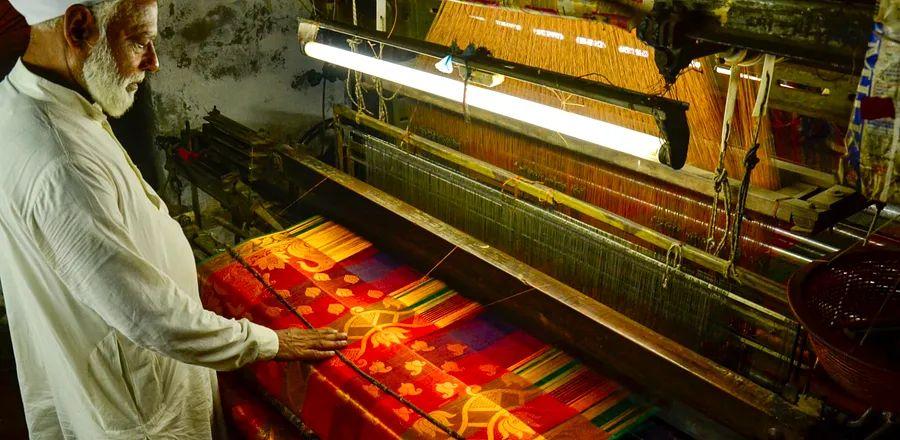The Silk Artisans of Varanasi

Leaning over his handloom, 50-year-old Abbas Ali glances up from the intricately woven emerald silk sari, greeting me with tired eyes. We find ourselves in a narrow alley within the bustling Bajardiha district, a hub of weaving families in the northern Indian city of Varanasi. Renowned as one of the holiest cities in the country, Varanasi is home to numerous temples with historical and cultural significance, including the Kashi Vishwanath temple, dedicated to the Hindu god Shiva, alongside cremation grounds nestled among its iconic ghats by the Ganges River. Each day, countless devotees come to pay their respects; many believe that dying and being cremated here leads to spiritual liberation.
Varanasi's identity has been shaped by Hindu, Muslim, and Buddhist traditions, influenced by its mythological connections to Shiva, its proximity to Sarnath—the site of the Buddha's first sermon—and its location along ancient trade routes by the Ganges. While the city is famed for its religious heritage, it is equally celebrated for its silk weaving. Across the globe, designers and brides seek out the renowned silk saris, known as “Banarasi saris,” meaning “saris from Varanasi.”
Historical records suggest that the origin of Banarasi silks dates back to the 16th and early 17th centuries when numerous weavers and merchants migrated from Gujarat in the west, bringing with them the craft of “warp and weft.” Here, “warp” refers to the vertically held threads on the loom, while “weft” pertains to the horizontally threaded shuttle. Upon their arrival in Varanasi, the quality of their silkwork captured the attention of the Mughal emperors, who ruled South Asia from the 16th to the 19th centuries, leading to a surge in popularity for these luxurious textiles. Today, these silks are often treasured as family heirlooms, integral to ceremonies and significant life events such as weddings.
However, in recent decades, local artisans have witnessed a troubling shift as many have adopted machine-operated power looms, edging handloom weavers out of their craft. Their concerns are heightened by the influx of cheaper, mass-produced synthetic silk saris and Chinese yarn, threatening the traditional artistry of pure silk and zari threads, typically made from gold or silver and intricately embroidered into Banarasi saris. A machine can produce three to four saris in a day, while a handmade sari can require anywhere from a week to several months, depending on its intricate design and embroidery details.
There are no official records tracking the decline, but master weaver Haseen Mohammad notes that changes began in the 1990s. “Back then, 75 percent of silk weavers worked by hand, while 25 percent used power looms,” he recounts. Today, however, those figures have flipped, with around 150,000 on power looms and only 25,000 preserving the traditional handloom method. Mohammad oversees nearly 70 artisans, skillfully creating brocades by hand. His multi-story home also serves as a warehouse, where the artisans operate from a spacious basement, while he manages finished products (saris) from the second floor.
Most of these artisans are Muslim, a detail increasingly hard to overlook amidst the rise of India’s Hindu nationalist government. One weaver, named Mohammad, feels that the lack of governmental support for this traditional craft suggests an implicit targeting of Muslim weavers.
For 23-year-old weaver Umm-e-Habiba, additional concerns arise: demonetization—where two major currency notes were banned, impacting weavers reliant on cash—and the Goods and Services Tax (GST) implemented by the right-wing Indian government in 2016 and 2017. Habiba works in a warehouse in Mubarakpur, approximately 60 miles from Varanasi, and is part of the roughly 22 percent of women in the Banarasi weaving community. A significant portion of artisans' earnings often goes to 'master weavers,' who typically reap most of the profits from sari sales. For a sari priced at nearly 10,000 rupees (US$122), handloom weavers earn between 1,500 to 2,000 rupees, or around $24 at most. “With a GST of almost 12 percent on our work and a 5 percent tax on yarn,” Habiba states, “these factors, along with demonetization, have made life challenging for us.”
Sixty-one-year-old Shahid Junaid, a member of the renowned 'Haji Munna' weaving family—known for catering to brides, designers, and influential locals since the 19th century—also highlights the disparities between handloom and power loom weavers. As an eighth-generation weaver, Junaid learned his craft by watching his father. Seated on a floor adorned with white mattresses in his warehouse, he showcases some notable Banarasi designs created by his artisans: a stunning jangla (jungle) sari featuring intricate floral and bird patterns, the shikargah (depicting hunting scenes), and individually embroidered butis (motifs) of paisleys and flowers on raw silk.
Junaid points out that handloom weavers often lack resources and face challenges in accessing state policy initiatives. The government provides electricity subsidies for power looms, which many weavers perceive as an unfair advantage favoring mechanization.
For Junaid, the charm of handwoven textiles lies in their individuality; each piece is a reflection of its creator. “If someone else were to take a seat at this loom and try to work on this sari, they wouldn’t be able to replicate the design because it has been shaped by a specific hand and foot size,” he explains. “Anyone can step in and operate a power loom, but that’s not true weaving.”
Abbas Ali shares this sentiment. “Power loom workers may claim to reap the benefits, but we are the true bunkars [members of the weaving community],” he asserts. “How can someone who relies on a machine truly be considered a weaver?”
Evaluation :
5/5



